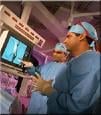
May 13, 2009 - The Society of Interventional Radiology (SIR) hailed the extension of an American College of Radiology (ACR) resolution in support of clinical patient management by vascular and interventional radiologists as an important reminder of the critical contribution these minimally invasive specialists bring to quality patient healthcare.
ACR encourages and supports the establishment of interventional radiology clinical services within the practice of radiology groups including establishment of an adequate clinical team; adequate space dedicated for clinical visits; inpatient admitting service; dedicated time for seeing inpatients and patients in a clinic; noninvasive vascular laboratory; clerical services for scheduling, insurance authorization and billing of procedures and evaluation/management services; and support for time and materials for promotional and educational efforts.
“Passage of ACR’s Resolution 22 is a continued endorsement of interventional radiology’s unique contribution of supporting innumerable clinical services while providing direct care,” said SIR President Brian F. Stainken, M.D., FSIR. “Interventional radiologists provide patients with the least invasive and most advanced treatment options for a wide variety of medical conditions, offering less risk, less pain and less recovery time when compared to open surgery,” noted Stainken. ACR endorsed interventional radiology’s clinical patient-centered nature 10 years ago, recognizing that interventional radiologists need an office presence, time allocated to see patients, time to consult with referring physicians and time to see patients on the ward, said Stainken, an interventional radiologist at Roger Williams Medical Center in Providence, R.I. Reaffirmation of that policy came during ACR’s 86th Annual Meeting and Chapter Leadership Conference May 5 in Washington, D.C.
The ACR policy support comes at a time when interventional radiologists have spent more than three decades working behind the scenes to solve the toughest medical problems, explained Stainken. “Interventional radiologists historically have worked on the sidelines as the ‘specialists’ specialist,’ helping other doctors manage their patients with the most difficult problems—for example, working collaboratively with surgeons with trauma and transplant care,” said Stainken. “While those physician relationships remain in place, interventional radiologists are taking positions in the front line of medical care. In delivering high-quality health care, interventional radiologists are formalizing their clinical role with offices, doing rounds and providing formalized consultation,” added Stainken.
“As members of the medical house of radiology, interventional radiologists differ greatly from diagnostic radiologists. Interventional radiologists are hands-on clinicians—who are known as innovative problem solvers and critical resources in tough medical situations—and expert board-certified radiologists. Interventional radiologists are a dozen subspecialist doctors rolled into one,” said Stainken.
According to the resolution, ACR “recognizes the importance of the development of a clinical service by interventional radiologists in order to appropriately manage patients.” ACR, which “opposes any attempt to prohibit vascular and interventional radiologists from being granted admitting and other clinical privileges based solely on their designation as radiologists,” affirmed the importance of vascular and interventional radiologists “establishing physician-patient relationships that are also customarily maintained by other physicians who provide comparable services.”
For more information: www.SIRweb.org


 August 06, 2024
August 06, 2024 








